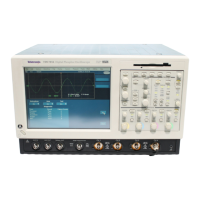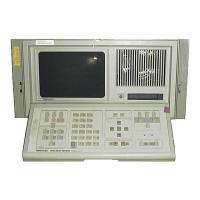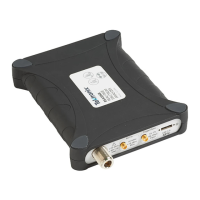Performance Tests
4- 132
CSA7404B, TDS7704B, TDS7404B, TDS7254B & TDS7154B Service Manual
where V
f
is the RMS of the voltage swing response at the bandwidth frequency
and V
DC
is the RMS voltage swing response at a frequency approaching DC.
Further math yields that V
f
= 0.707 ¢V
DC
. The expression is simplified by the
cancellation of the R and the movement of the squared term inside the log
expression to a multiple outside the log expression:
10 × log
⎪
⎧
⎩
V
f
2
R
V
DC
2
R
⎪
⎫
⎭
= 2 × 10 × log
Ꮛ
V
f
V
DC
Ꮠ
= 20 × log
Ꮛ
V
f
V
DC
Ꮠ
therefore at
–3 dB
V
f
V
DC
= 0.707
In some instances, the vertical units displayed for an optical signal are not in
voltage, but are in watts, which is a unit of power. The O/E converter outputs a
voltage swing whose amplitude is linearly dependent on the incoming optical
power swing. In this condition the voltage applied at the electrical sampler
already represents Optical Power in its linear form (as opposed to having to
square the voltage and divide by R). For the O/E converter, then, the bandwidth
where the displayed optical power is one half that approaching DC is:
dB = 10 × log
Ꮛ
Power
f
Power
DC
Ꮠ
= –3 dB
The V
f
in such a system is one half (0. 5) the V
DC
as opposed to 0.707. The
optical bandwidth, therefore, corresponds to the traditional electrical bandwidth
at --6 dB. During testing of O/E converter via impulse testing, the resulting
impulse waveform is converted to frequency via Fourier transform, and the
bandwidth is defined as:
− 3 dB = 10 × log
Ꮛ
vertical swing @ frequency
vertical swing @ DC
Ꮠ
This definition is used for bandwidth settings.
During reference receiver curve calculation, however, the definition is changed to
match the industry standard definition, which was authored assuming electrical
bandwidths where:
− 3 dB = 20 × log
Ꮛ
vertical swing @ frequency
vertical swing @ DC
Ꮠ
This definition is used for reference receiver settings.
This procedure checks the minimum optical bandwidth of the instrument.
